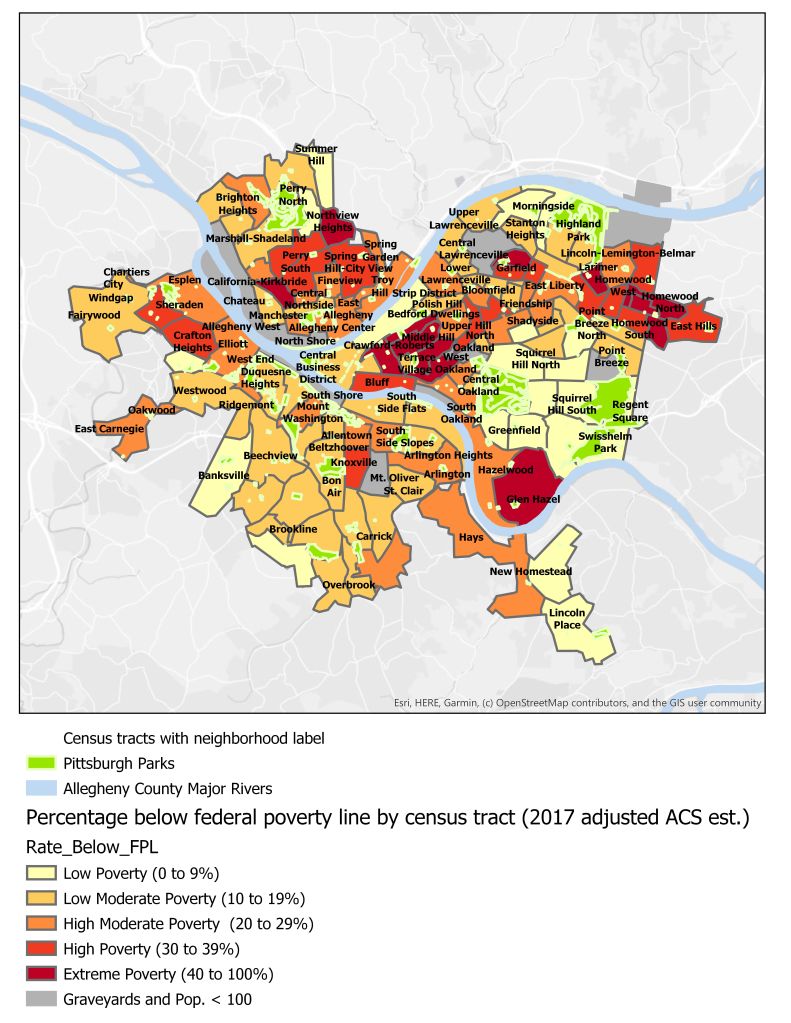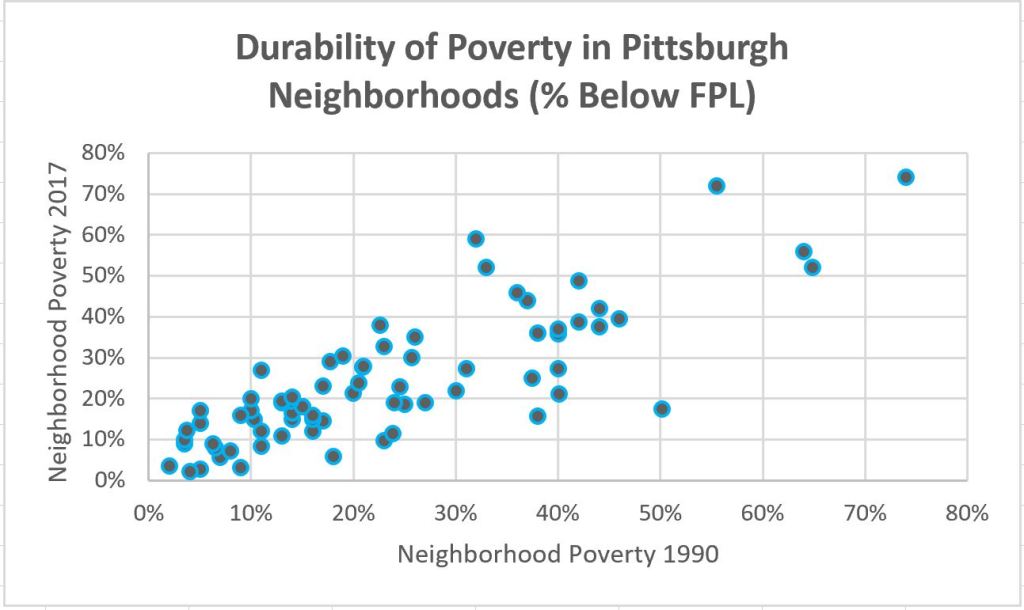Before we start taking an intimate look at each Pittsburgh neighborhood as this project evolves, I wanted to share some evidence regarding the other goal of this project as a whole; exploring the reality of lasting, cemented and durable concentrated poverty in Pittsburgh neighborhoods and the city’s high degree of residential segregation by race and income.
At a glance, the City of Pittsburgh is estimated to have a total population of about 302,414. Pittsburgh is a largely White city (65%) with the second largest racial group being Black people (22%). The other notable racial groups are Asian (6%) and Hispanic or Latino (roughly 3%) – with multiracial residents and very small numbers of other minority racial groups taking up the small remainder. When excluding neighborhoods in the East End that are in close proximity to the city’s universities (and have heavy concentrations of college students), Pittsburgh’s small and native Hispanic or Latino population is highly concentrated in neighborhoods like Mount Oliver Neighborhood, Crawford-Roberts, the Beltzhoover/Bon Air area and Mount Washington (in that order by percentage) and in Beechview, Greenfield, Brookline and Mount Washington (in that order by total number). Much like the Latino or Hispanic population, the Asian population is almost entirely concentrated in neighborhoods around Pittsburgh’s universities in the East End when those neighborhoods aren’t excluded – with the highest percentage concentrations in North Oakland, Shadyside, Friendship, Squirrel Hill South and Squirrel Hill North. As such, it is likely that Asian residents in these neighborhoods are largely students or graduate transplants – as is likely with the Latino or Hispanic population. The exception is a growing population of southeast Asian refugees and immigrants settling in neighborhoods like Carrick, Brookline, Banksville and the Ridgemont and Westwood area (in that order by total number) and in Banksville, the Ridgemont and Westwood area, Knoxville and the Strip District (in that order by percentage). Other than these minority racial variations, the city’s neighborhoods are largely dominated by White and Black hues. While about 1 and 5 Pittsburghers fell below the Federal Poverty Line (FPL) in 2017, roughly 13% of White individuals in Pittsburgh did and 35% of Black Pittsburghers did – despite the fact that Black people makeup only 22% of the overall population (American Community Survey or ACS 1-Year Estimates for the year 2017).
Nearly mirroring city-wide racial demographics, 68% of Pittsburgh’s neighborhoods and neighborhood areas are majority White and 23% are majority Black – with a total of 17 majority Black neighborhoods and a total of 50 majority White neighborhoods and neighborhood areas. Populations that are either 51% Black or White at the neighborhood level constitute a simple racial majority in this analysis. The remaining neighborhoods and neighborhood areas are racially mixed neighborhoods with no clear majority (9% of neighborhoods and only 7 total). As such, truly racially mixed neighborhoods are rare in Pittsburgh. And as will be discussed in future neighborhood profiles, there is little evidence that these racially mixed neighborhoods with no clear simple racial majority were integrated by intentional design. The high poverty Knoxville is one such racially mixed neighborhood with a Black population of 46% and a White population of 40% – with the remainder composed of mixed races and other minority racial groups. The collapse of the Steel Industry, relatively cheap rental units, and the displacement of Black families from the St. Clair Village Public Housing project in the 2000s may account for such a mixing in neighborhoods such as Knoxville. Those residents with means to do so often chose to leave the Knoxville neighborhood as it began to decline, according to some residents I spoke with. There’s a saying that Steelers’ fans “travel well” – given their spread throughout the U.S. However, after the collapse of the steel mills and the effect such a collapse had on the entire regional economy, many of these Steelers’ fans left for economic opportunity else where. Much like racial separation, Pittsburgh neighborhoods are highly divided by the percent of their respective populations below the Federal Poverty Line. 24% of Pittsburgh neighborhoods are high or extreme poverty, 22% are moderate poverty and the remainder are low or very low poverty (54%). And all too often, racial and economic segregation are not mutually exclusive in Pittsburgh neighborhoods. In fact, they are overwhelmingly tied together (ACS 5-Year Estimates for the year 2017).

Even though Black people make up only 22% of Pittsburgh’s population, an overwhelming 76% of majority Black neighborhoods are high or extreme poverty – with high poverty defined as neighborhoods with overall poverty rates ranging from 30% to 39% and extreme poverty defined as those with at least 40% or more. And often, poverty percentages in majority Black neighborhoods considered high or extreme were far above these research-defined thresholds – with a range of 30% to 74% of individuals living below the FPL. Six percent of majority Black neighborhoods are moderate poverty and the remaining majority Black neighborhoods are low poverty (18%). As in, only 3 majority Black neighborhoods are considered low poverty: East Liberty, Manchester and the Upper Hill – which all had poverty rates between 10% and 19%. Virtually no majority Black neighborhoods are considered very low poverty – defined as those neighborhoods with poverty rates less than 10%. On the other side of the racial spectrum, White neighborhoods fair very differently regarding poverty makeup. Only 6% of majority White Neighborhoods are high poverty and none are considered extreme poverty. As such, there were only 3 high poverty areas that were majority White: the Bluff, the neighborhood area of Hays, Hazelwood and Glen Hazel – which all share a census tract(s) as of the 2010 census – and the upper Northside hilltop neighborhood of Spring Hill-City View. 26% of majority White neighborhoods were considered moderate poverty with poverty rates between 20% and 29% and the overwhelming remainder were either low or very low poverty (68%) (ACS 5-Year Estimates for the year 2017).
As presented, race and class are often closely tied together at the neighborhood level in Pittsburgh. And this phenomenon is true of cities across the nation (see researcher Robert Samson’s Chicago and the Enduring Neighborhood Effect). However, Pittsburgh’s unique topographical features, its “bus in-to-town and bus out-of-town” port authority system and its highway and busway structures make said divide even more pronounced and isolating. Of those extreme poverty neighborhoods, 0% were white and 88% were black. The only neighborhood area that was also extreme poverty and not majority Black was the racially mixed Terrace Village and West Oakland area – with each neighborhood sharing a census tract as of the most recent census. However, the bulk of the neighborhood area’s poverty comes from the largely Black Terrace Village. And so, if this neighborhood area is removed from the mix, 100% of extreme poverty neighborhoods are majority Black.
Northview Heights is a strong example of a neighborhood that is geographically isolated with limited port authority access – as compared to many neighborhoods in the city’s East End – and has a staggering 74% poverty rate. The population is not just majority Black, but overwhelmingly black (91%). And only 2% of its population is White. In fact, 54% of majority White neighborhoods are overwhelmingly White – as are 53% of black ones; meaning that in these cases at least 75% of a neighborhood’s population is a given racial group rather than just a simple racial majority of 51%. Of those neighborhoods considered high poverty, 30% are White and 60% are Black – with the remaining percentage coming from the racially mixed Knoxville. As such, only a small portion of White residents live in high or extreme poverty neighborhoods. Such White residents exist along with smaller makeups of racially mixed residents and Asian and Latino refugees and immigrants. However, the majority of White neighborhoods are low or very low poverty. The subject of White versus Black poverty for a given neighborhood or neighborhood area will be a feature of the neighborhood profiles.
Lastly, neighborhood poverty level does not tend to change over time for the majority of Pittsburgh neighborhoods. As can be seen in the figure below, there is a strong linear relationship between neighborhood poverty rate in 1990 and neighborhood poverty rate in 2017 (R=.82 with alpha set at less than .01). And neighborhood poverty rate in 1990 explains 67% of the variance around the mean regarding neighborhood poverty rate in 2017. To get around the science speak, this means that despite broad macro-economic changes at the national level and economic changes and growth at the city level over a period of 27 years, low poverty neighborhoods tend to remain low poverty, moderate poverty neighborhoods tend to remain moderate or get poorer and high poverty neighborhoods tend to remain high poverty or get poorer.

There are a few neighborhoods that have seen steep declines in poverty rate from 1990 to 2017, but most neighborhoods have remained stable. Neighborhood areas like Arlington and Arlington Heights (a 19% decline) and neighborhoods like Terrace Village (a 13% decline) most likely saw steep declines because of the removal of a substantial portion of public housing by the city from the 1990s and on through the 2000s. St. Clair Village is one example of a neighborhood that was once a public housing project and is now being developed as an Urban Farm; it was no longer assigned its own census tract due to having little to no population as of more recent ACS surveys. Neighborhoods like Manchester (22% decline), the East Allegheny and North Shore area (12% decline) and the Strip District (12% decline) may have seen steep declines due to intentional public and private investment and development – along with historic preservation efforts and an influx of higher income residents. Neighborhoods with a large share of low-income renters and limited affordable housing supply are often the most at risk regarding involuntary displacement due to intentional investment and the subsequent residential demand (and rise in rents), but most poor neighborhoods have not been the target of such investment. And often, low and fixed-income tenants face the possibility of eviction no matter where they live. Meaning, involuntary displacement is not just a possible consequence of neighborhood change and revitalization, but rather a reality for most low or fixed-income residents in even Pittsburgh’s poorest neighborhoods; neighborhoods that haven’t substantially changed for decades.
As will be discussed in future posts, such a degree of racial separation is not merely due to self-preference or selection alone. Instead, and broadly speaking, such division exists because of historical and present discrimination in housing and lending markets, urban renewal, major changes in the labor market from the 1980s onward and subsequent economic restructuring and major demographic changes and out-migration from the 1950s to the 1980s (see researcher William Julius Wilson’s the Truly Disadvantaged, Rothstein’s the Color of Law and a Coates’ the Case for Reparations to get a detailed account of these processes). And as will also be discussed in future posts, research shows that childhood development in high poverty areas is tied to a number of negative outcomes in adulthood and is strongly tied to generational poverty. And experimental research show that low-income children who primarily grow up in low poverty neighborhoods before the age of 12 have positive outcomes as compared to their peers who remain in high poverty ones (see researcher Raj Chetty’s work with the Moving to Opportunity experiment). Patrick Sharkey’s Stuck in Place also explores the effect of cumulative concentrated disadvantage on childhood development and respective adult outcomes over multiple generations (and Vox did a great write-up of Sharkey’s research here). And so, neighborhoods tend to stay the same without intentional intervention. Neighborhoods effect and shape our lives, behaviors and opportunities in a significant way. As such, it is quite troubling that such a large portion of Pittsburgh’s Black population is often living in isolated areas of lasting concentrated poverty and disadvantage. This fact will become more evident as the project continues on with resident interviews and Neighborhood Profiles.
Methodology Notes:
The analysis of Pittsburgh neighborhoods and neighborhood areas used American Community Survey (ACS) 5-Year Estimates for the year 2017 – as collected from the U.S Census. 2017 estimates are the most recent year regarding published data from the ACS. Citywide data came from 2017 ACS 1-year estimates. Because the census tracts that makeup Pittsburgh neighborhoods have changed over time the University of Pittsburgh Library System was referenced to inform which census tracts comprised a given neighborhood in both 1990 and 2017. As of the 2010 census, a number of neighborhoods shared the same census tract. In these cases, neighborhoods were combined. Neighborhoods that were combined with another neighborhood were referred to as neighborhood areas. Any time that a neighborhood was comprised of more than one census tract or was combined due to sharing a census tract(s) with another neighborhood a weighted average was used to construct neighborhoods. Weights were based on census tract population proportions.
Regarding the total population of neighborhoods and neighborhood areas used, the Chateau, St. Clair and South Shore neighborhoods were not included in the analysis because they had populations of less than 100. Neighborhoods with student heavy residential populations and neighborhoods that contained a 4-year university were included but their poverty rates were adjusted by using estimates for those ages 25 and up who were below the FPL – as to control for student heavy populations. Because the average college student is unemployed or working a minimum wage job, student heavy centers dramatically skew the real poverty rate. This is not to say that the analysis ignores the reality of low-income college students. Rather, neighborhood poverty rates were adjusted because of the difficulty in accessing the true poverty rate. In total, 74 neighborhoods and neighborhood areas (those neighborhoods that share a census tract(s) with another neighborhood) were used in the analysis. For the durability of poverty analysis from 1990 to 2017 data from the National Historic Geographic Systems was utilized to collect census level poverty estimates for the year 1990. Poverty rates were not adjusted to control for student populations in the durability of poverty regression analysis because the purpose of the analysis was to show how little poverty rate changes over time in most Pittsburgh neighborhoods; and student inflated poverty rates in 1990 are very much comparable to student inflated poverty rates in 2017.
As should be noted, ACS estimates are notorious for wide margins or error (MOE) due to smaller than optimal sample sizes. As such, MOE may impact results. That being said, the degree to which Pittsburgh neighborhoods are segregated by race and income appears to have an impact on the accuracy of estimates – despite high MOE. Meaning, because neighborhoods are often so overwhelmingly comprised of residents with similar socio-economic and racial demographics, smaller sample sizes are often more representative than they should be. As such, ACS estimates should not be disregarded because of high MOE. Rather, they should be taken with a grain of salt and checked against the working knowledge of those with professional and personal experience in a given neighborhood.
And on this note, while durability of poverty tends to be the trend in Pittsburgh neighborhoods, there are several neighborhoods that have been emerging at a steep pace regarding housing demand and subsequent rental prices. As such, 2017 estimates may not accurately portray current racial and poverty measures for the year 2019 in neighborhoods like Lower and Central Lawrenceville, East Liberty and the western portion of East Allegheny (commonly known as Deutschtown). Fixed-income and low-income renters, and even low-income home owners, are at risk of involuntary displacement without affordable housing and property tax protections, respectively.
I’d be happy to send info on which data tables I used from the census for those interested. Thanks for reading and please feel free to share or use the data as long as you cite this page as the source.

Leave a comment